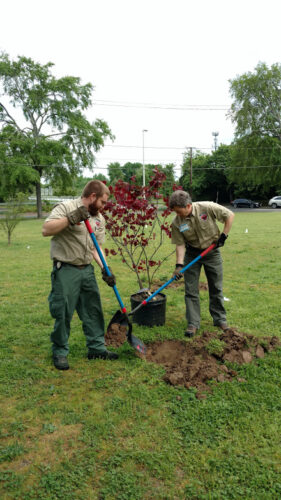
Tree Selection and Planting
Right Tree, Right Place
Many trees planted each year by well-meaning homeowners and community workers will never flourish because they are hopelessly unsuited for the conditions in which they are placed. Before rushing in to plant just any available trees, do enough research and planning to ensure success.
Factors to Consider
- Plant hardiness zone and heat tolerance
- Native plant species vs. non-native plant species
- Planting location and surroundings
- Microclimates
- Desired tree function
- Season of planting
Taking a bit of time to plan before putting a tree in the ground will save money and headaches in the future. When choosing a tree, make sure to do a complete site evaluation to understand the conditions and ensure the best tree for the site chosen.
When to Plant
It is best to plant while the trees are dormant in late fall, winter, or early spring.
Deciduous trees planted in the fall, after the heat of summer diminishes, have several months to re-establish their root system and often emerge healthier the next spring than those transplanted in the heat of summer.
Evergreens should only be planted in late winter or early spring – but beware of foliage drying and “winter burn”. Unlike deciduous trees, evergreens hold onto their foliage throughout the winter, and to keep them green they need a lot of moisture. Bright sun and harsh winds in the winter months can cause the needles to lose moisture, and plant roots cannot take up enough water from the soil in frozen ground, which can cause dry foliage and “winter burn”. In newly planted trees where the root system is already too small for the canopy, this problem is made worse.
Planting Different Types of Nursery Stock
Trees may be purchased as bare-root, container-grown, or balled and burlapped. Correct planting and initial maintenance are essential for a long, healthy life for your tree. The most common cause of poor tree health is poor planting: too deep, too shallow, or in too small an area. The objective is to plant the tree so that the root flare at the bottom of the trunk is at (or slightly above) the surrounding ground level.
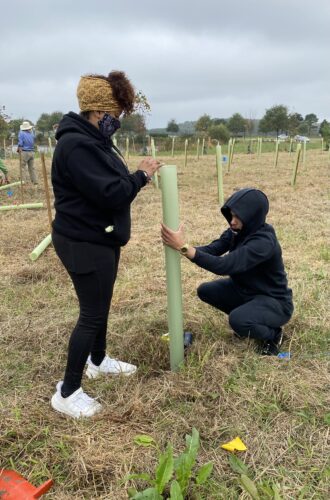
 The most important thing to remember when choosing to plant bare-root trees is you must not let the roots dry out. Soak roots in water before, during and after planting to ensure good contact with the surrounding soil. Follow these steps for successful planting:
The most important thing to remember when choosing to plant bare-root trees is you must not let the roots dry out. Soak roots in water before, during and after planting to ensure good contact with the surrounding soil. Follow these steps for successful planting:
- Gently prune away any dry, damaged, and broken roots using a sharp tool.
- Dig a shallow planting hole no deeper than the roots will be when they are spread out.
- Make the hole wider than the root system to allow for spreading.
- When planting large bare-root stock, backfill with native soil while watering simultaneously, creating a slurry of mud to cover the roots.
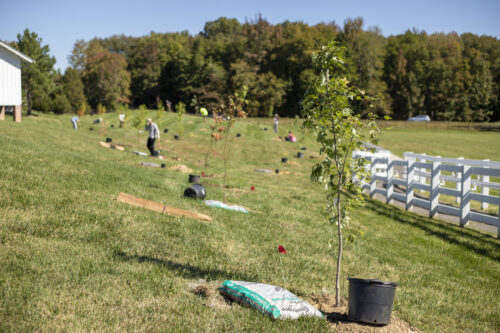
Trees sold in containers are the most common type of stock found in nurseries. When moving a tree, always pick it up by the container and NOT by the trunk!
- Dig the planting hole the same depth as the tree is growing in the container. Caution: Sometimes growing medium surrounding the tree in the container is above the root flare and the excess should be removed.
- Make the planting hole at least two to three times wider than the container.
- Remove the tree from the container before planting.
- Container-grown trees may show circling roots that should be straightened out to prevent later girdling and to encourage natural root growth. Trees are constantly growing and shedding the fine absorbing roots that are lost in this process, and root pruning will stimulate new root growth.
- Place the tree in the planting hole and backfill with native soil.
- Use your boot to gently press on the backfill soil to ensure good root to soil contact.
- Water your newly planted tree.
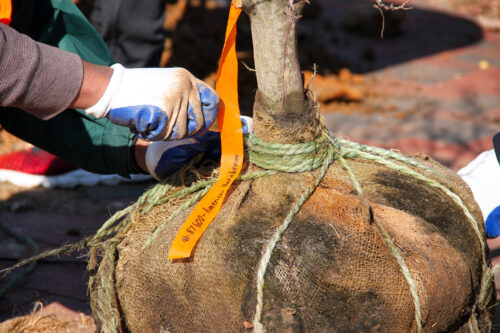
Trees sold balled and burlapped are usually larger stock that instantly add impact to the area in which you are planting. They are quite heavy and require multiple hands to successfully plant them. When moving a tree, always pick it up by the root ball or binding strings and NOT by the trunk!
- Dig the planting hole the same depth as the root ball. Caution: Sometimes growing medium surrounding the tree in the burlap is above the root flare and the excess should be removed.
- Make the diameter of the planting hole at least two to three times wider than the root ball.
- Remove all or as much packaging – string, wire basket and burlap – from the root ball as practical before planting the tree. Note: Do not worry if this causes deterioration of the root ball. The soil in the root ball is there to protect the roots during shipping.
- Place the tree in the planting hole and backfill with native soil.
- Use your boot to gently press on the backfill soil to ensure good root to soil contact and to rid the soil of air pockets.
- Water your newly planted tree.
Additional Resources
- Learn more about plant hardiness zones.
- Learn more about tree care.
- Learn more about tree identification.
| Image | Title | ID | Description | Date | Content Type | View | hf:tax:document-category | hf:tax:Media |
|---|---|---|---|---|---|---|---|---|
| Tree Owner’s Manual for the Northeastern and Midwestern United States | P00218 | Manual provides guidance on proper tree care from planting to maintenance throughout the tree’s life. Produced by USDA Forest Service (NA-FR-04-07), cover created by DOF. Printed copies available. | 11/01/2025 | Publication | View | urban-and-community-forestry | publication | |
| Seedling Price Guide | P00139 | Brochure lists seedling species available for sale at state nurseries with current pricing. Visit our Web Store for detailed species information and to order online. Printed copies available. | 09/01/2025 | Publication | View | nurseries | publication | |
| Identification Guide Book Order – In-Person Sales | 13.04 | Use this order form to request books for purchase and pickup in person. | 07/08/2025 | Form | View | public-information | form | |
| Basic Tree Identification | By Ellen Powell, Conservation Education Coordinator – Presentation reviews the basics of tree identification. | 08/29/2024 | Presentation | View | education forest-management public-information training human-resources | presentation | ||
 | Acorn and Nut Identification Guide | FT0060 | Forestry topic information sheet helps in identifying the most common acorns and nuts in Virginia to assist in the collection for our nursery. | 08/21/2024 | Publication | View | education nurseries public-information | publication |
| Hardwood Planting Guide | P00137 | Brochure illustrates and explains proper planting techniques for planting bare-root hardwood seedlings. Printed copies available. | 08/12/2024 | Publication | View | nurseries | publication | |
| Pine Planting Guide | P00117 | Brochure illustrates and explains proper planting techniques for planting bare-root pine seedlings. Printed copies available. | 08/12/2024 | Publication | View | nurseries | publication | |
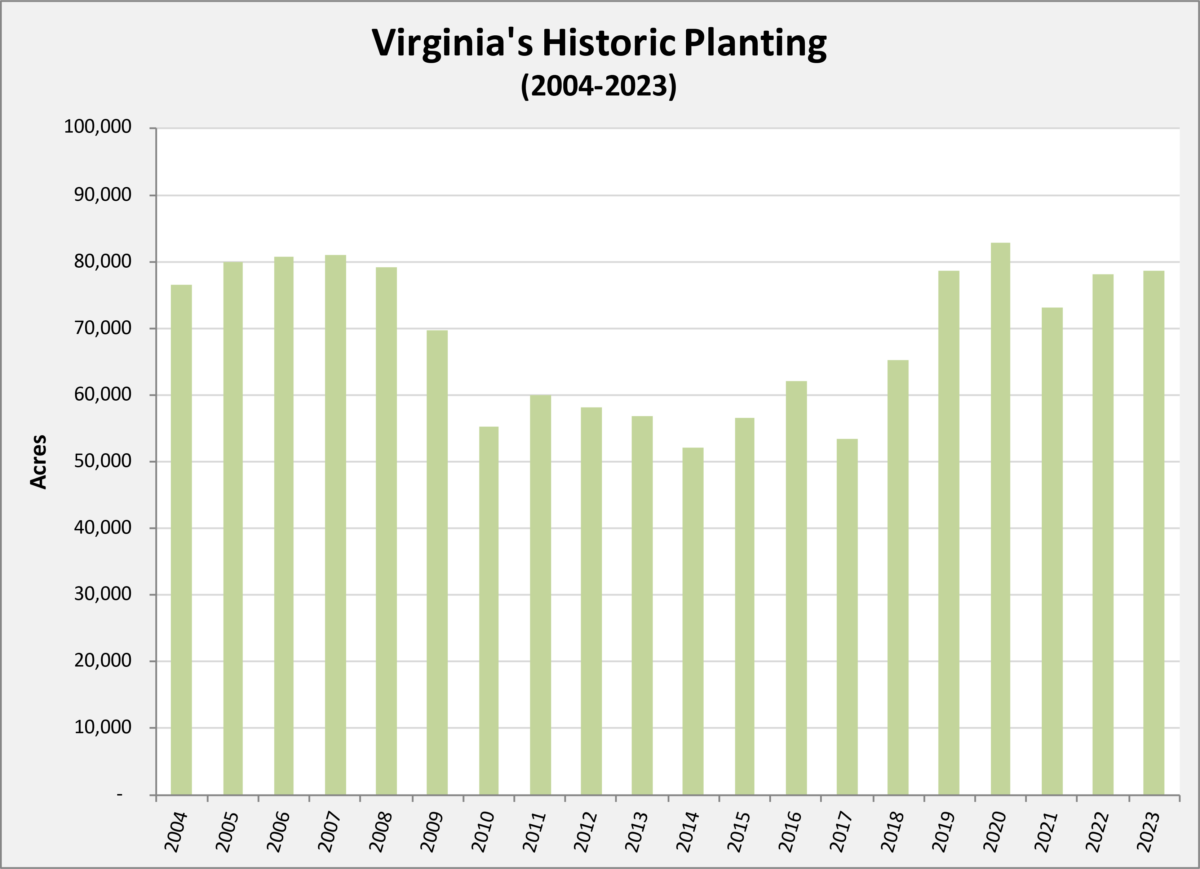 | Virginia’s Historic Planting Chart | Chart shows the acres planted in Virginia over a 20-year time frame. | 02/01/2024 | Graphic | View | forest-inventory-analysis forest-management resource-information | graphic | |
| Common Native Shrubs and Woody Vines of Virginia: Identification Guide | P00027 | Identification book is a favorite of teachers, Scout leaders and outdoor enthusiasts. Book features descriptions, line drawings and an identification key to the most common native Virginia shrubs and woody vines. It also contains hints for effective plant identification, invasive species threats, and more. Printed copies available for sale. | 03/01/2022 | Publication | View | education public-information | publication | |
 | Common Native Shrubs and Woody Vines of Virginia: Identification Guide (2-page-spread) | P00027 | Identification book is a favorite of teachers, Scout leaders and outdoor enthusiasts. Book features descriptions, line drawings and an identification key to the most common native Virginia shrubs and woody vines. It also contains hints for effective plant identification, invasive species threats, and more. Printed copies available for sale. | 03/01/2022 | Publication | View | education public-information | publication |
| Common Native Trees of Virginia: Identification Guide | P00026 | Identification book is a favorite of teachers, Scout leaders and outdoor enthusiasts. Book features descriptions, line drawings, and an identification key to the most common native Virginia trees. It also contains hints for effective plant identification, invasive species threats, and more. Printed copies available for sale. | 03/01/2022 | Publication | View | education public-information | publication | |
 | Common Native Trees of Virginia: Identification Guide (2-page spreads) | P00026 | Identification book is a favorite of teachers, Scout leaders and outdoor enthusiasts. Book features descriptions, line drawings, and an identification key to the most common native Virginia trees. It also contains hints for effective plant identification, invasive species threats, and more. Printed copies available for sale. | 03/01/2022 | Publication | View | education public-information | publication |
 | Bark Types | Pictorial sheet showing the types of bark with photo samples of each. | 01/01/2021 | Document | View | education public-information | document | |
 | Community Tree Planting During COVID-19 – Be Safe, Keep Planting! | FT0054 | Forestry topic information sheet provides information about safely holding community tree planting events during the COVID-19 pandemic, including guidance for planning, supplies, and more. | 01/01/2021 | Publication | View | urban-and-community-forestry | publication |
 | How To Kill A Tree | Poster demonstrates the most common mistakes made that negatively impact tree health. Printed copies available. | 03/01/2020 | Publication | View | urban-and-community-forestry | publication | |
| A Training Manual for Virginia Tree Stewards 4th Edition – Volunteers for the Community Forest | This training manual includes 10 units, including Tree Anatomy, Tree Physiology, Environmental Factors Affecting Trees, Tree Identification, Tree Selection, Tree Planting and Care, Tree Pruning, Tree Problems and Diagnosis, Invasive Species in Virginia, and Trees and People in the Community. | 01/01/2020 | Publication | View | urban-and-community-forestry | publication | ||
 | Best Practices for Establishing Eastern White Pine – Based Upon Years of Research | FT0023 | Forestry topic information sheet provides information about best practices to be used in establishing Eastern white pine to encourage the best possible survival. | 08/01/2014 | Publication | View | forest-management | publication |
 | Reforesting Cutover Timberland – Pine… A Good Investment | FT0004 | Forestry topic information sheet provides guidance to landowners about reforesting their cutover timberland, including planning, site preparation, planting, and checking survival. Printed copies available. | 11/01/2011 | Publication | View | forest-management | publication |
| Property Mulching Techniques | Publication explains proper mulching techniques, including type, amount, and method. | 01/01/2011 | Publication | View | urban-and-community-forestry | publication | ||
 | Environmental Quality Incentives Cost-Share Program – Project Success Stories | FT0009 | Forestry topic information sheet provides “success stories” portraying real-life experiences of Virginia forest landowners who have used Environmental Quality Incentives Program (EQIP) cost-share assistance to accomplish sustainable forest management activities. Printed copies available. | 08/01/2010 | Publication | View | financial-assistance-forest-management forest-management | publication |
 | Facts About Low-Density Plantings of Loblolly Pine – Advantages of Planting Fewer Trees Per Acre | FT0003 | Forestry topic information sheet provides guidance to landowners about low-density planting for loblolly pine, including forest health, thinnings, wood quality, and return on investment. | 12/01/2008 | Publication | View | forest-management | publication |
Contact Us
For more information or questions about urban tree planting, e-mail us or use our contact form.
For more information or questions about planting bare-root seedlings from our nurseries, e-mail us or use our contact form.
